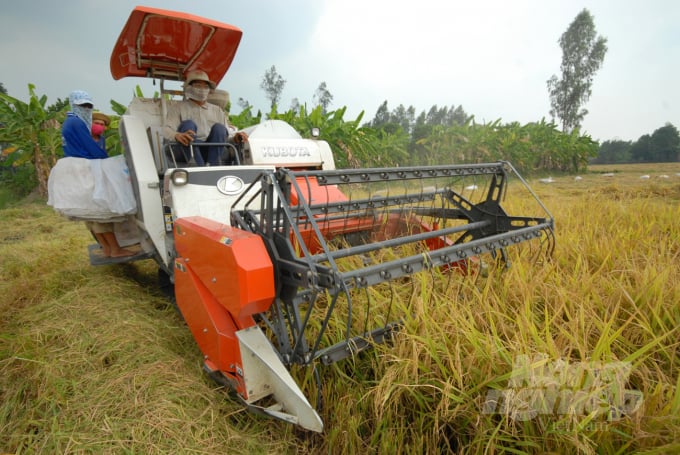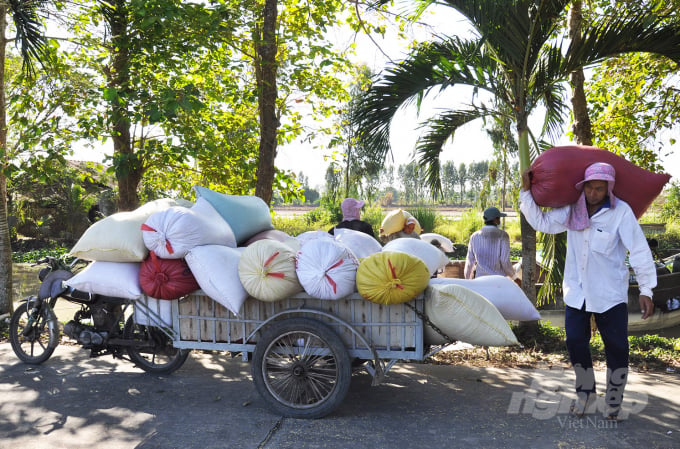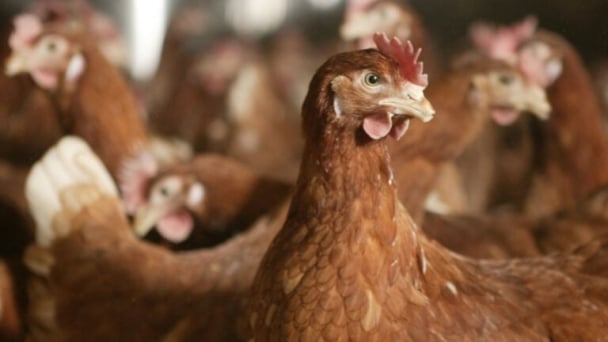June 23, 2025 | 20:47 GMT +7
June 23, 2025 | 20:47 GMT +7
Hotline: 0913.378.918
June 23, 2025 | 20:47 GMT +7
Hotline: 0913.378.918

“Big paddy” production linkages accelerate the mechanization process in Soc Trang. Photo: Huu Duc.
The Mekong Delta is the largest key agricultural production area in Vietnam. Favored by nature, the land has many advantages in the fields of cultivation, livestock, poultry and aquaculture.
However, through the process of tectonic history and socio-economic development, the household production scale per unit area of land has gradually narrowed.
Out of the total 1.5 million ha of rice cultivation area in the whole region, households’ average rice-growing area is only about 0.4 - 0.5 ha/household. Land for rice production is divided into many small and fragmented fields, leading to many obstacles when applying for new technical advances. As a result, productivity and agro-product quality are uneven, and production efficiency has gone below expectation.
In March 2011, the Ministry of Agriculture and Rural Development officially initiated the “big paddy” development in rice production, following the trend of association with rice businesses underwriting products for farmers.
This was considered one of the core solutions to improve the rice value chain and at the same time a suitable choice in the condition where farmers have small arable land which overcame the weaknesses in small-scale production.
Agricultural economic experts assessed that the early years of implementing production linkages to develop “big paddy” in the Mekong Delta were quite successful. The “big paddy” model not only increased the number of participants and rice underwriting contracts but also the quality of rice.
After the first five years, from the model “big paddy” with a scale of 30 - 50 ha, the production scale and production linkage had expanded, forming a movement to build “big paddy” up to 200-300 ha. The total “big paddy” area in the Mekong Delta increased to more than 175,000 ha.
However, even during the years when the movement of linking rice production under the “big paddy” model flourished, including the number of member businesses in the Vietnam Food Association (VFA) that have signed individual contracts with agricultural cooperatives in localities, the total “big paddy” area in the Mekong Delta did not exceed 200,000 ha. In the following years, localities had always encouraged and created conditions for businesses and agricultural cooperatives to link production, but the development process of building large fields has shown signs of slowing down without much improvement.

Traders go directly to the fields to buy rice. Photo: Huu Duc.
According to an agricultural officer in the Mekong Delta with many years of monitoring the development of “big paddy”, the first reason was the objective factor from the market. The consumption price of rice products and profit did not guarantee the benefits for both parties participating in the association. There were also reasons related to the state's supporting policies and mechanisms.
Reflecting on reality, Soc Trang at that time had 145,000 ha of rice land. In 2010, the province soon "launched" a model of a 40-hectare sample paddy in Truong Khanh commune, Long Phu district. Then, in the 2012-2013 winter-spring crop, Soc Trang province expanded to 106 “big paddies” with a total of 12,000 ha. But 7 years later, the expansion clearly showed signs of slow growth, reaching only approximately 17,000 ha.
The biggest weakest that slowed down the expansion of “big paddy” stemmed from the linkage contract not being strict. Although the contract was properly signed, the terms were loose and not legally binding, so gradually the contract content was reduced.
Most of the parts in the contract to sell rice at the end of the season did not possess much binding on technical cultivation conditions and harvesting requirements, so it was easy for one of the two parties to make excuses that lead to failure, unable to perform as originally committed.
On the other hand, the production linkage seemed unsustainable as it relied heavily on the situation of the rice market in terms of strong - weak consumption, winter-spring or summer-autumn rice crops, or the number of enterprises participating being more or less.
Due to those reasons, although many localities have formed cooperatives and cooperative groups, farmers who want to increase the scale of “big paddy” still face a passive situation, waiting for businesses to link up seasonally. Only time can tell how enterprises, cooperatives and cooperative groups find a common voice, keep credibility, and share benefits and risks in harmony, moving towards sustainable business.
Translated by Samuel Pham

(VAN) Research has shown that Hy-Line brown hens may be better suited for cage-free production based on overall greater egg production and other quality metrics.
![Turning wind and rain into action: [9] Digitizing hydrometeorological data in response to climate change](https://t.ex-cdn.com/nongnghiepmoitruong.vn/608w/files/news/2025/06/17/z6704423696987_15fd32ffc26d590d204d520c9dac6786-nongnghiep-165943.jpg)
(VAN) Farmers have begun accessing hydrometeorological applications to adjust their cropping schedules, aiming to ensure productivity and adapt to climate change.
![Turning wind and rain into action: [8] Real-time salinity detection and early warning technology](https://t.ex-cdn.com/nongnghiepmoitruong.vn/608w/files/news/2025/06/17/z6704423696987_15fd32ffc26d590d204d520c9dac6786-nongnghiep-151127.jpg)
(VAN) Thanks to the integration of modern hydrological-hydraulic models, remote sensing technologies, and artificial intelligence, the accuracy of hydrological forecasting has significantly improved.
![Turning wind and rain into action: [7] Early disaster warnings help marine farmers minimize losses](https://t.ex-cdn.com/nongnghiepmoitruong.vn/608w/files/news/2025/06/17/z6704423696987_15fd32ffc26d590d204d520c9dac6786-nongnghiep-142942.jpg)
(VAN) In recent years, thanks to early disaster warnings and forecasting, marine farmers in Khanh Hoa province have been able to reduce risks and losses, thereby improving production efficiency.
![Turning wind and rain into action: [6] ‘Four on-the-spot’ disaster management software](https://t.ex-cdn.com/nongnghiepmoitruong.vn/608w/files/news/2025/06/17/e5a48259d6a262fc3bb3-nongnghiep-183800.jpg)
(VAN) By simply activating the scenario on the disaster management software, the relevant authorities immediately know how many households need to be evacuated, where to evacuate them to, and by what means of transportation…
![Turning wind and rain into action: [5] Hue applies modern technology in disaster forecasting](https://t.ex-cdn.com/nongnghiepmoitruong.vn/608w/files/news/2025/06/17/z6704423696987_15fd32ffc26d590d204d520c9dac6786-nongnghiep-093938.jpg)
(VAN) In Hue city, modern technology has recently been applied in meteorological and hydrological forecasting and warning, helping to reduce the damage caused by natural disasters.

(VAN) A cutting-edge farming technique being implemented on an experimental ranch in Arizona's Sonoran Desert has already saved a billion gallons of water over five years, according to Civil Eats.